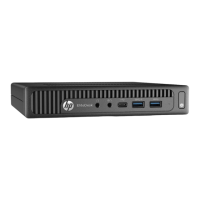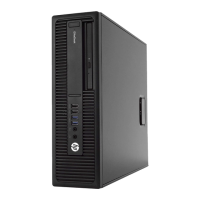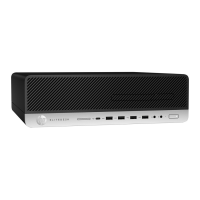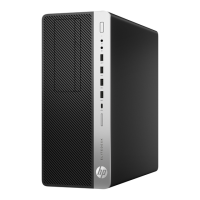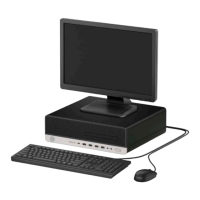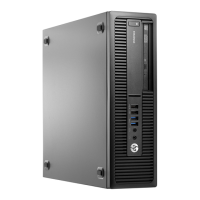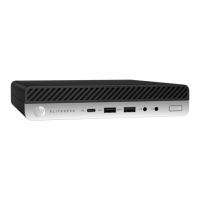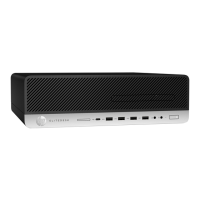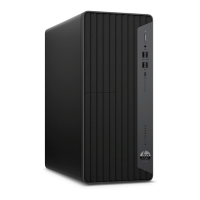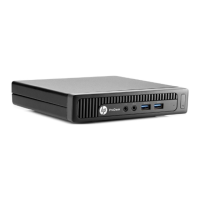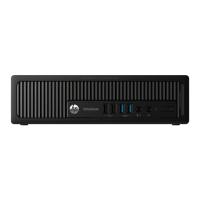Do you have a question about the HP EliteDesk 800 G2 SFF and is the answer not in the manual?
Describes the standard configuration and components of the computer, including orientation options and sleep state recommendations.
Details the components located on the front of the computer, including ports, connectors, and indicator lights.
Identifies and describes the connectors and ports on the rear panel of the computer.
Explains where to find the unique serial and product ID numbers for customer service.
Lists and illustrates major computer components like access panels, bezels, system boards, and power supplies.
Illustrates and lists various smaller components such as baffles, speakers, fans, and connectors.
Details various types of hard drives (HDD, SSD) and their specifications.
Provides essential information on preventing damage from electrostatic discharge (ESD) to components.
Offers advice on operating the computer to prevent overheating and prolong its lifespan.
Covers general safety precautions for cleaning computer components like the case and keyboard.
Outlines important factors to consider during disassembly and assembly, including tools and screws.
Details the necessary steps to prepare the computer for disassembly, including safety precautions.
Provides instructions for removing and installing the computer's access panel.
Describes the procedure for removing and installing the front bezel of the computer.
Explains memory specifications, DIMM types, and the process for installing memory modules.
Details how to remove, replace, or add PCI Express expansion cards to the system.
Covers the installation and removal of various drive types, including optical and hard drives.
Provides instructions for removing and replacing the system board and its components.
Overview of functions and capabilities of the Computer Setup (F10) Utility.
Details options available in the Main section of Computer Setup, including system information.
Explains security settings within Computer Setup, such as BIOS administrator passwords and TPM.
Covers advanced configuration options for boot devices, power management, and built-in devices.
Addresses common issues like system lock-ups, startup failures, and response problems.
Provides solutions for power-related issues such as intermittent shutdowns and failure to turn on.
Helps diagnose and resolve issues related to hard drive errors, transactions, and detection.
Offers solutions for display issues like blank screens, fuzzy video, and incorrect resolution.
Addresses common audio issues such as sound cutting out or no sound from speakers/headphones.
Provides troubleshooting steps for keyboard and mouse not responding or behaving erratically.
Guides on resolving network connectivity issues, including driver detection and setup.
Details solutions for memory errors, incorrect counts, and insufficient memory during operation.
Offers troubleshooting for CD-ROM/DVD drives not detected, not reading discs, or playback issues.
Addresses issues with USB flash drives not being recognized, found, or booting the system.
Helps resolve problems connecting to the internet and launching online applications.
Covers common software issues like incorrect installation, conflicts, and error messages.
Lists POST error codes, messages, and recommended actions for diagnosing system startup issues.
Explains how to interpret blink/beep codes to identify hardware and system board failures.
Provides steps to clear system passwords by resetting the password jumper.
Details the procedure for clearing CMOS settings to reset BIOS to factory defaults.
Instructions on how to download and create HP UEFI support environment on a USB device.
Covers creating recovery media, backups, and restoring the system in Windows 10.
Steps for creating HP-specific recovery media for system recovery.
Information on safeguarding data and retrieving it using tools for Windows 8.1 and Windows 8.
Guides on backing up, restoring, and recovering system data and settings in Windows 7.
Step-by-step instructions for safely replacing the computer's internal lithium coin cell battery.
Lists general requirements for power cord sets applicable to all countries.
Specifies the required power cord set for use in Japan.
Instructions for restoring non-volatile memory by flashing the BIOS and resetting defaults.
Provides detailed technical specifications for the Small Form Factor (SFF) chassis.
| Chassis type | SFF |
|---|---|
| Product color | Black |
| Country of origin | China |
| Number of 2.5\" bays | 1 |
| Number of 3.5\" bays | 2 |
| Product type | PC |
| Motherboard chipset | Intel® Q170 |
| Tcase | 71 °C |
| Bus type | DMI3 |
| Stepping | R0 |
| Processor cache | 8 MB |
| Processor cores | 4 |
| Processor model | i7-6700 |
| System bus rate | 8 GT/s |
| Processor family | Intel® Core™ i7 |
| Processor series | Intel Core i7-6700 Desktop series |
| Processor socket | LGA 1151 (Socket H4) |
| Processor threads | 8 |
| Processor codename | Skylake |
| Processor frequency | 3.4 GHz |
| Processor cache type | Smart Cache |
| Processor lithography | 14 nm |
| Processor manufacturer | Intel |
| Processor front side bus | - MHz |
| PCI Express slots version | 3.0 |
| Processor boost frequency | 4 GHz |
| Processor operating modes | 64-bit |
| ECC supported by processor | No |
| PCI Express configurations | 2x8, 1x8+2x4, 1x16 |
| Thermal Design Power (TDP) | 65 W |
| Maximum number of PCI Express lanes | 16 |
| Memory types supported by processor | DDR3L-SDRAM, DDR4-SDRAM |
| Memory voltage supported by processor | 1.35 V |
| Memory clock speeds supported by processor | 1333, 1600, 1866, 2133 MHz |
| Memory bandwidth supported by processor (max) | 34.1 GB/s |
| Maximum internal memory supported by processor | 64 GB |
| Memory slots | 4x DIMM |
| Internal memory | 8 GB |
| Memory channels | Dual-channel |
| Memory clock speed | 2133 MHz |
| Internal memory type | DDR4-SDRAM |
| Memory layout (slots x size) | 1 x 8 GB |
| SSD capacity | The Solid State Drive's storage capacity in Gigabytes. |
| Storage media | SSD |
| Optical drive type | DVD Super Multi |
| Card reader integrated | - |
| Total storage capacity | 256 GB |
| On-board graphics card | Yes |
| On-board graphics card ID | 1912 |
| Discrete graphics card model | Not available |
| On-board graphics card model | Intel® HD Graphics 530 |
| On-board graphics card family | Intel® HD Graphics |
| Maximum on-board graphics card memory | 1.74 GB |
| On-board graphics card OpenGL version | 4.4 |
| On-board graphics card base frequency | 350 MHz |
| On-board graphics card DirectX version | 12.0 |
| On-board graphics card dynamic frequency (max) | 1150 MHz |
| Number of displays supported (on-board graphics) | 3 |
| Ethernet LAN data rates | 10, 100, 1000 Mbit/s |
| Power supply | 200 W |
| USB 2.0 ports quantity | USB 2.0 ports have a data transmission speed of 480 Mbps, and are backwards compatible with USB 1.1 ports. You can connect all kinds of peripheral devices to them. |
| USB 3.2 Gen 1 (3.1 Gen 1) Type-C ports quantity | 0 |
| Scalability | 1S |
| Processor code | SR2BT |
| Processor ARK ID | 88196 |
| Processor package size | 37.5 x 37.5 mm |
| Supported instruction sets | SSE4.1, AVX 2.0, SSE4.2 |
| Thermal solution specification | PCG 2015C |
| Intel Secure Key Technology version | 1.00 |
| Intel segment tagging | Enterprise |
| Depth | 425 mm |
|---|---|
| Width | 170 mm |
| Height | 389 mm |
| Weight | 6900 g |
